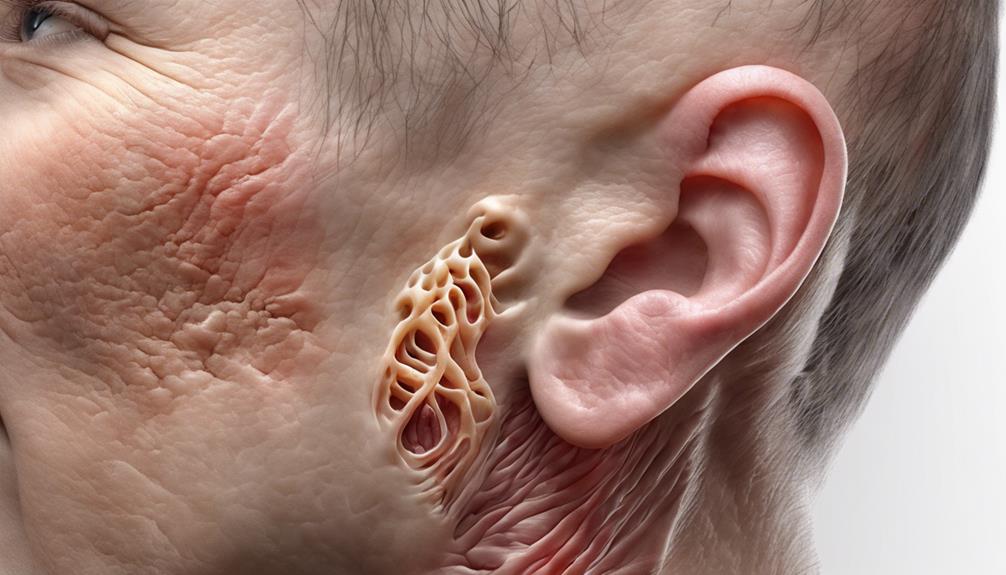Your ear’s anatomy includes the outer part (pinna) that captures sound, guiding it through the ear canal to your eardrum (tympanic membrane), which vibrates in response to sound waves. These vibrations transfer to tiny bones (ossicles) in the middle ear that amplify and transmit the signals to your inner ear. Understanding how each part works together helps you appreciate your hearing process even more—if you look closer, you’ll discover how each component contributes to this intricate system.
Key Takeaways
- The outer ear includes the pinna and ear canal, which collect and direct sound toward the eardrum.
- The ear canal maintains a protective, slightly acidic environment and amplifies certain sound frequencies.
- The tympanic membrane (eardrum) vibrates in response to sound waves, converting them into mechanical signals.
- The middle ear contains ossicles (malleus, incus, stapes) that amplify vibrations for the inner ear.
- Visual guides highlight ear structures’ roles in sound collection, transmission, and overall auditory function.

The ear is a complex organ responsible for hearing and balance, and understanding its anatomy helps you appreciate how these essential functions work together. When you look into the structure of your ear, you’ll notice the outer part, known as the pinna, which helps capture sound waves and direct them inward. These sound waves enter your ear canal, a tube that extends inward toward the middle ear. The ear canal isn’t just a passive passage; it protects the delicate inner parts of your ear and maintains a slightly acidic environment to prevent infections. The shape and length of the ear canal influence how you perceive different frequencies and contribute to your sense of sound localization.
At the end of the ear canal lies the tympanic membrane, commonly called the eardrum. When sound waves reach this membrane, they cause it to vibrate. These vibrations are critical because they serve as the first step in transforming airborne sound into signals your brain can interpret. The tympanic membrane acts as a barrier that separates the outer ear from the middle ear, and its vibrations are transferred to three tiny bones—the ossicles—in the middle ear. These bones are the malleus, incus, and stapes, and they amplify the vibrations, making it easier for your inner ear to detect them.
Understanding the role of the ear canal and tympanic membrane helps you see how sound is initially collected and processed. The ear canal’s shape and length influence how you perceive different frequencies, giving you a sense of direction and distance of sounds. Meanwhile, the tympanic membrane’s ability to vibrate efficiently depends on the sound’s intensity and frequency, which directly impacts your hearing clarity. Any damage or infection affecting the ear canal or tympanic membrane can cause hearing loss or discomfort, highlighting their significance in your auditory health. Additionally, the health of the tympanic membrane and ear canal can be affected by various conditions, emphasizing the importance of maintaining ear hygiene and protection.
Moreover, the tympanic membrane isn’t just a passive barrier—it’s a living tissue that can heal if injured, and its health is essential for proper hearing. The ear canal also plays a role in protecting your middle and inner ear from debris, insects, and water. You might notice that your ear canal produces wax, which traps dirt and reduces the risk of infections. This wax acts as a natural barrier, reinforcing the protective function of the ear canal and helping maintain overall ear health.
In short, the ear canal and tympanic membrane form the gateway for sound entry and initial processing. Their structure and function are fundamental for converting sound waves into the mechanical vibrations that your brain ultimately interprets as hearing. By understanding these parts, you gain a better appreciation of how your ear works to keep you connected to the world of sound. Recognizing the importance of ear health can help you take steps to protect this vital organ.
Frequently Asked Questions
How Does the Ear Convert Sound Waves Into Electrical Signals?
When sound waves reach your ear, they travel through the ear canal and vibrate the eardrum. These vibrations move to the inner ear, where tiny hair cells convert them into electrical signals. The auditory nerve then carries these signals to your brain, allowing you to perceive sound. Your inner ear acts as the key converter, turning mechanical vibrations into the electrical signals that your brain interprets as hearing.
What Causes Common Ear Infections and How Are They Treated?
Ear infection causes often include bacteria, viruses, or fungi entering through the ear canal, leading to inflammation. You might experience pain, swelling, or fluid buildup. For ear infection treatment, doctors typically recommend antibiotics for bacterial infections, pain relievers, or warm compresses. It is crucial to keep your ears dry and avoid inserting objects. Prompt treatment helps prevent complications and relieves discomfort, so see a healthcare professional if symptoms persist.
How Does the Ear Maintain Balance and Spatial Orientation?
Balance begins with your brain, but your ear’s vestibular system plays a starring role. It senses changes in head position and motion, activating equilibrium mechanisms that keep you steady. When you tilt or turn, tiny hair cells in the semicircular canals detect movement, sending signals to your brain. This seamless system helps you stay balanced and oriented, whether you’re walking, spinning, or stopping suddenly.
Can Ear Anatomy Vary Significantly Between Individuals?
You might notice that ear size and ear shape vary widely among individuals. These differences are normal and result from genetic factors, developmental processes, and ethnicity. While the overall structure of the ear remains consistent, subtle variations in size and shape can influence how your ears look and sometimes affect hearing or balance. So, yes, ear anatomy can differ markedly from person to person, making each set of ears unique.
What Are the Latest Advancements in Hearing Aid Technology?
You’ll find that the latest advancements in hearing aid technology include innovative hearing devices that use sophisticated digital signal processing. These devices enhance sound quality, reduce background noise, and adapt automatically to your environment. With features like wireless connectivity and rechargeable batteries, these advancements make hearing aids more comfortable and convenient, improving your overall hearing experience markedly. Staying updated ensures you benefit from the most effective and user-friendly solutions available today.
Conclusion
Now that you’ve explored the intricate anatomy of your ear, think of it as your personal lighthouse, guiding sound safely to your mind. Just like the ancient mariners relied on their lighthouses, your ear’s delicate structures guarantee you catch every whisper and melody. Respect this marvel of nature, for it’s your gateway to the world of sound. Keep it healthy, and let your ear be a steadfast beacon, illuminating life’s symphony around you.











